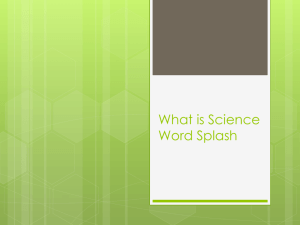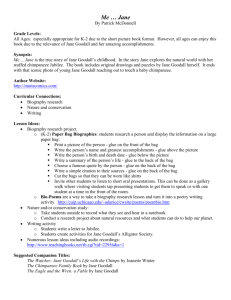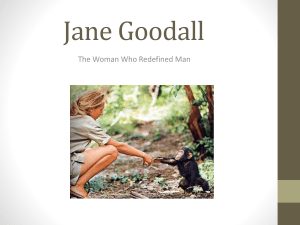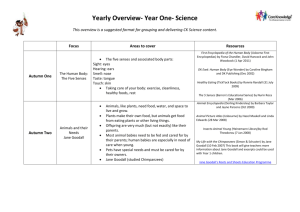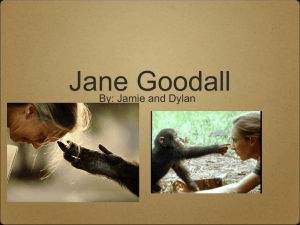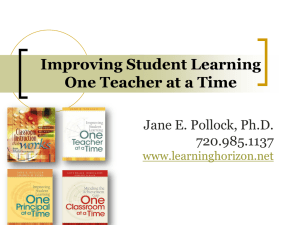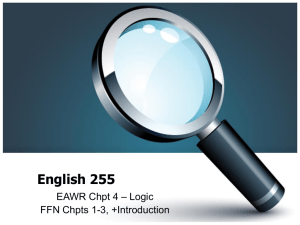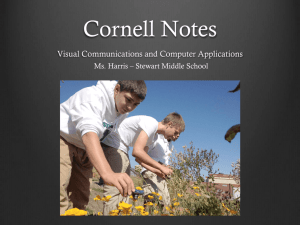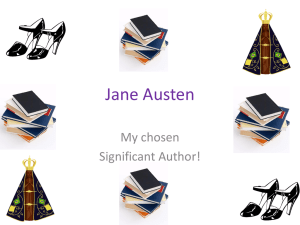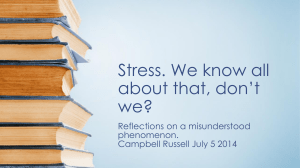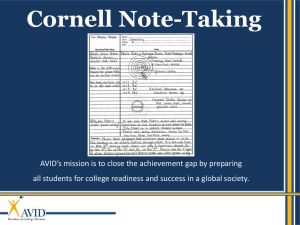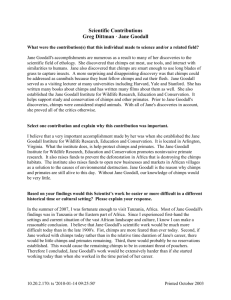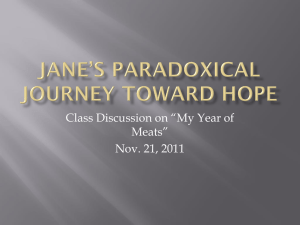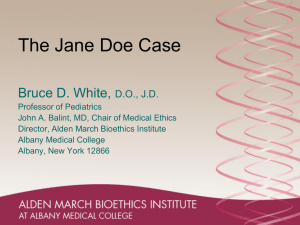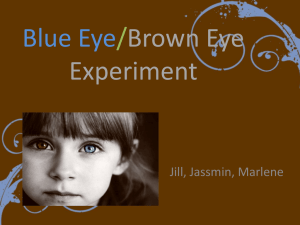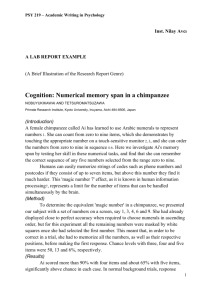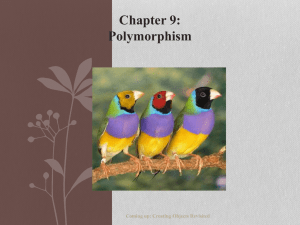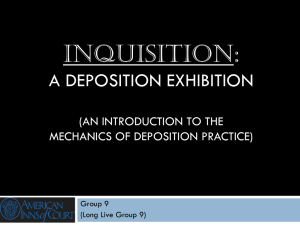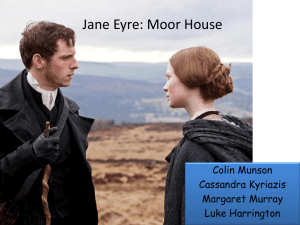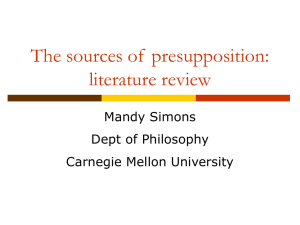Jane Goodall Notes
advertisement
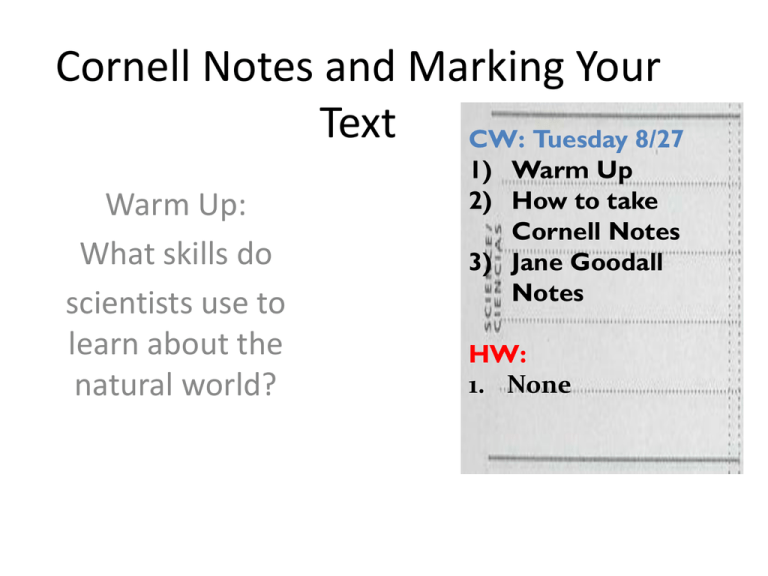
Cornell Notes and Marking Your Text CW: Tuesday 8/27 Warm Up: What skills do scientists use to learn about the natural world? 1) Warm Up 2) How to take Cornell Notes 3) Jane Goodall Notes HW: 1. None What you’ve always wanted to know about… Cornell Notes Oh, you know you do!... Introduction • How did you learn to take notes? • How skilled are you at note-taking? • How do you think taking good notes can contribute to your success as a student in middle school? • Are there any other benefits to notetaking skills? Sometimes you take notes while listening to your teacher in class. Sometimes you take notes while you read (a textbook, or a poem, etc.) Sometimes you take notes when watching a film, or a PowerPoint presentation. Where did this technique come from? •Developed in 1949 at Cornell University by Walter Pauk. •Designed in response to frustration over student test scores. •Meant to be easily used as a test study guide. •Adopted by most major law schools as the preferred note taking method. •Used by A.V.I.D. students world-wide! Cornell notes • Start by drawing a 2.5 inches column to the left-hand edge of each paper. The left-hand side is used to write questions about the notes on the right. You can also use symbols, pictures or memory clues on the lefthand column to help you remember the notes on the right hand side. The right-hand side is used for facts, details, examples, graphic organizers and pictures. Remember to skip a line between import ideas to help with organization. A 2 inch summary section is made after the notes have been taken for the day. Here you will reflect and summarize the days note taking information. After Lecture… • Re-read your notes….look for places you may need to clarify… • You can work with a partner! • Use a highlighter or can underline important points in your notes. Finally… After taking your notes… fill in the left hand column with questions, symbols pictures or any other memory clues. Why do you do this? Because…... You can always cover the right-hand column with a piece of paper…and by reading your questions or looking at your pictures, symbols or memory clues you can see if you can remember the right-hand side information. Put paper over the right-hand side. Use memory clues to remember your notes on the right side.. How take out a piece of paper.. • Set up your Cornell note format….. • Now lets take notes Jane Goodall.... jane goodall As you watch the video ask yourself… What skills and attitudes do scientist need? Cornell Notes and Marking Your Text CW: Wednesday 8/28 Warm Up: What are some qualities and personal traits that all scientists have in common. 1) Warm Up 2) Jane Goodall Notes HW: 1. Vocab Cards • • • • • • • • • • • Observing Qualitative Observation Quantitative Observation In your groups Inferring Predicting chose three words Classifying and discuss what Modeling you think each word Curiosity means….. Open-mindness Creativity Honesty observing What does observing mean? • Using one or more of your senses to gather information. Qualitative Observation • Descriptions that does not deal with numbers. The chimpanzee is black, hairy, as large as a human, smells like the earth and has fingernails. Quantitative Observation • Descriptions that does deal with numbers. The chimpanzee has 2 ears, 1 nose, 10 fingernails, and is 556 cm tall. The chimp picked off a handful of leaves from the tree and chewed on them. Then it took the leaves out of its mouth and pushed them into the tree hollow. When the chimp pulled the leaves back out, Jane saw the gleam of water. The chimp then put the wet leaves back in its mouth. What was the chimpanzee doing? Jane reasoned that the chimpanzee might be using the chewed leaves like a sponge to soak up water. • Jane was…… Inferring Making an inference doesn’t mean guessing wildly. Inferences are based on reasoning from what you already know. Predicting • Through her observations, Jane learned that when a chimpanzee is frightened or angry, its hairs stand on end. This response is sometimes followed by threatening gestures such as charging, throwing rocks, and shaking trees, or even an attack. Therefore, if Jane sees a chimp with its hairs on end, she can predict that there might be danger and move away. Predicting means… Making a forecast of what will happen in the future based on past experience or evidence. Classify • Suppose Jane wanted to know how much time Jomeo spent feeding or resting that morning. She could find out by classifying Jomeo’s actions into several categories Classify • Jane could group together all the information about Jomeo’s feeding habits or his resting behavior. This would also make it easier to compare Jomeo’s actions to those of other chimps. • Classify means… Is the process of grouping together items that are alike in some way. Modeling • How far do chimpanzees travel? Where do they go? Sometimes, Jane’s research team would follow a particular chimpanzee for many days at a time. Jomeo’s journey through the forest over the course of one day. • • This is a model of Jomeo’s journey. Modeling • Making models involves creating representations of complex objects or processes. • Models help people study and understand things that are complex or that can’t be observed directly • Now…..take a pencil and draw a picture of what the meaning means to you on the front of each vocabulary word card. • Observing • Qualitative Observation • Quantitative Observation • Inferring • Predicting • Classifying • Modeling • Curiosity • Open-mindness • Creativity •Honesty
